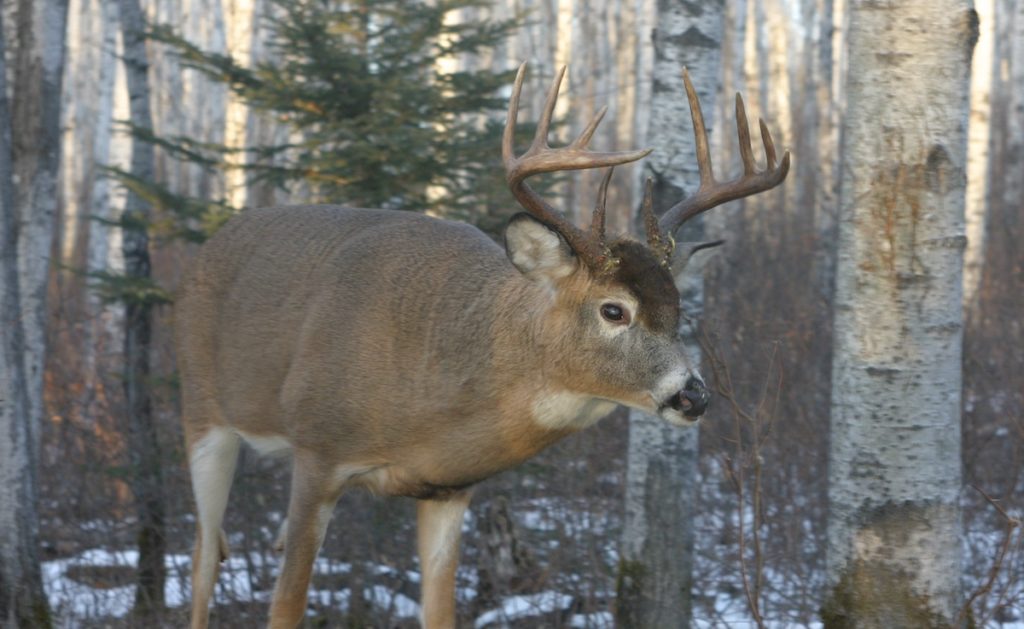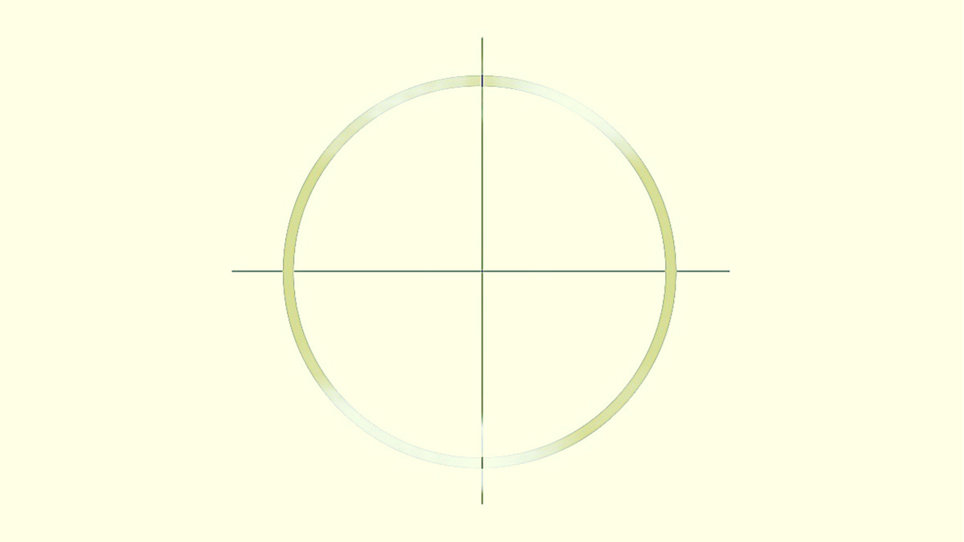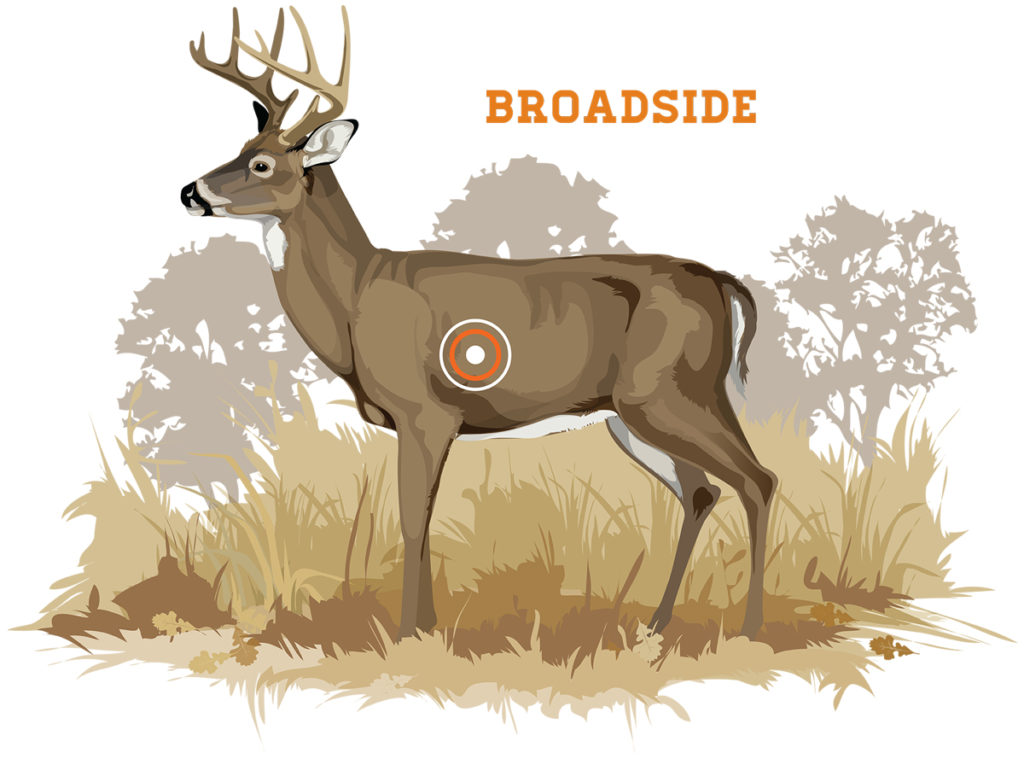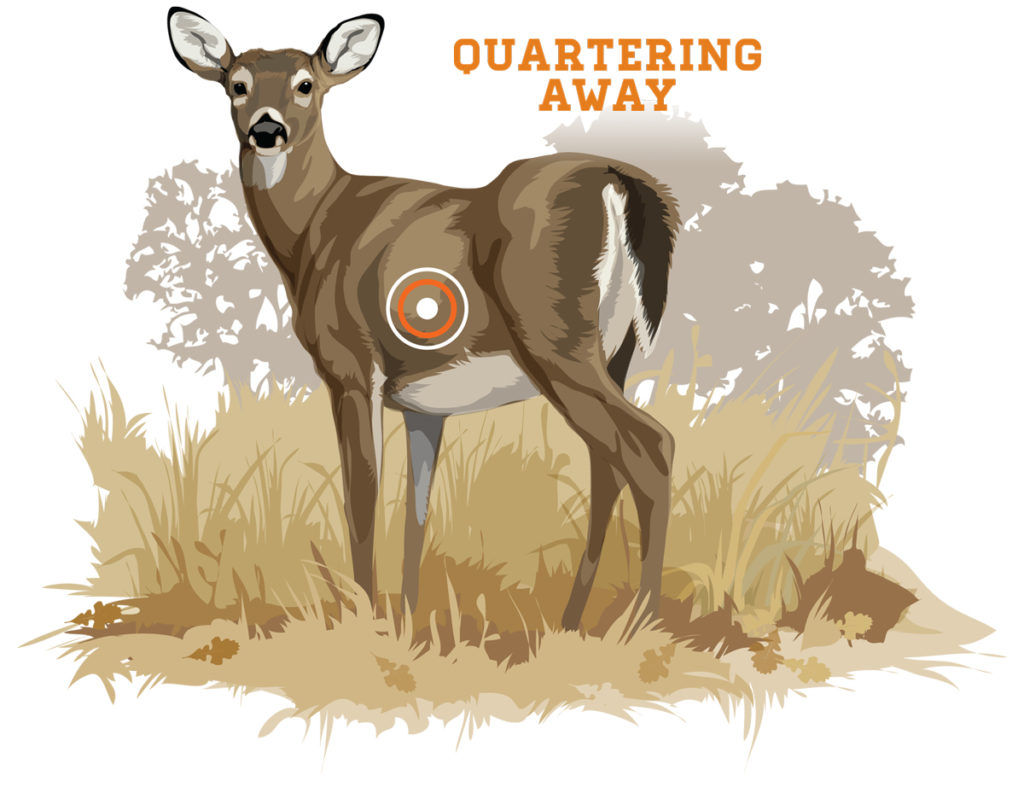“X” marks the spot on most whitetail targets with a position firmly one-third up the body and tight behind the shoulder. And that's where to shoot a deer. It works, too, until a whitetail deer shows up in your shooting lane at an angle you hadn’t even anticipated.
The Broadside Shot
Broadside shot is the ideal angle and it gives the bowhunter a straight shot to exposed vitals and a large target for a lethal hit.
The Archery Trade Association's Bowhunting 360 website offers these two steps for the broadside shot:
Step 1
When aiming at a broadside deer at ground level, visually divide its body into three equal horizontal segments. The top section of the bottom third is the vertical hold-on reference.
Step 2
Aim at that height and 3 inches behind the crease where the deer’s shoulder meets its midsection. The red dot on the photo shows where those two hold-on points intersect, creating the aiming point.
Another tip for accuracy and preparation is to consider your hunting tool. An arrow’s broadhead kills by slicing through vital tissues. This causes extreme hemorrhaging or it can cut holes through the lungs stopping the organ’s ability to inflate. For broadheads to create the most bleeding possible they must be surgically sharp. When they reach their target they need produce in the range of 45 to 65 foot-pounds of energy.
Related: Make the first shot count
Conversely, a bullet or slug kills by massive, hydrostatic shock to a deer’s body. For bullets to kill efficiently they need to expand and plow a devastating wound channel through the deer. Most experts agree that a bullet should be hitting its target with approximately 1,000 foot-pounds of energy. Modern deer shotguns teamed with technologically-advanced ammunition, such as Hornady’s SST Shotgun Slugs, can also retain more than 1,100 foot-pounds of energy, even to 200 yards.
Meet these parameters with bow or firearm and any broadside shot in “the pocket” should cleanly take down a whitetail in a matter of seconds.
Of course a broadside shot may not materialize.
Quartering-Away Shot
Your next best option is a quartering-away shot. Visualize the position of the far leg and aim for it using an aiming point approximately one-third up the body. Even though you’ll need to drive a bullet or broadhead through some paunch space, it should reach into the vitals for a quick end to the hunt.
Quartering-To Shot
On the flip side is the quartering-to shot. This one becomes a bit trickier due to the skeletal makeup of a deer. Rib bones, leg bones and the bladed shoulder all create obstacles for a clean pass into the vital zone. With a bow, it’s best to avoid this shot as the wounding rate increases exponentially. At close range with a tested bullet, this shot is doable with a firearm. Aim just above where the leg meets the body and hedge toward the neck by approximately four inches.

The quartering-to shot can be tricky, especially for archery tackle when a broadhead needs to navigate through a system of bones. If possible, wait for a broadside shot. Photo: Mark Kayser
Straight-On Shot
Straight on is also a possibility. With archery gear, once again, it’s advised not to take this shot for fear of hitting a rib bone which could cause an arrow deflection. For a steady firearm shot it is doable, but your vital zone is decreased significantly. If possible, wait for a better angle. If you do take the shot, aim one-third up and center the reticle.
Walking Away Shot
If you encounter a deer walking away, you can consider the “Texas heart shot.” Consider it, but don’t take it. The bullet or arrow has a long way to travel to reach the vital zone and if you don’t damage a main artery you risk losing the deer.
The same is true of the head. It is a small target and all it takes is for a deer to snap its attention in the other direction as you fire to create a disastrous, wounding outcome. You lose little rib meat from an ethical, broadside shot. Wait and take it.
Lastly, read this hunting disclaimer. Bullets and broadheads react differently when hitting individual animals due to a variety of reasons. Angle of the shot, vegetation deflection, wind drift, extreme body size, animal movement and even bone, and muscle definition can redirect your projectile. Crazy projectile travel is more common with broadheads due to these matters, but it can occur with bullets or slugs. If you question any element of the shot, it’s best to wait for a textbook opportunity and an X-marks-the-spot target.
Related: Can better shooting lead to better meat?








